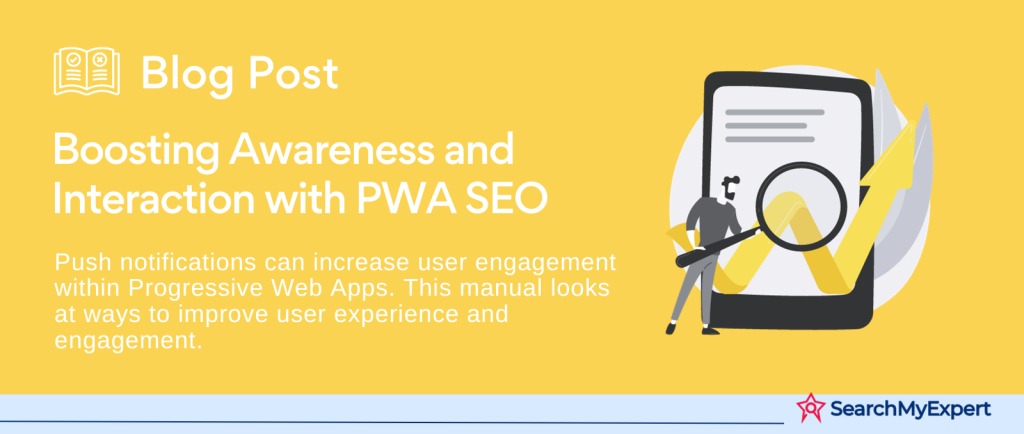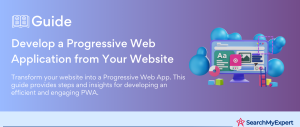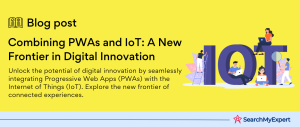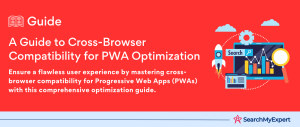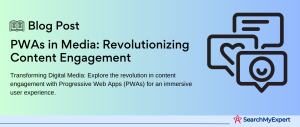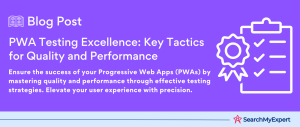Understanding the Puzzle – PWAs and SEO
Progressive Web Apps (PWAs) have emerged as a powerful and efficient way to deliver a high-quality web experience. Their rise in popularity begs the question of how they interact with search engine optimization (SEO). This comprehensive guide will unravel the mysteries surrounding PWAs and their impact on SEO, highlighting their key features, aligning these strengths with search engine ranking factors, and debunking common misconceptions.
Demystifying PWAs: Key Features and Their Impact on Search Visibility
What are Progressive Web Apps?
- PWAs are a blend of traditional web pages and mobile applications. They offer the functionality of a native app, such as offline access and push notifications, while being accessible through a web browser.
Key Features of PWAs
- Offline Access:
Thanks to service workers, PWAs can function offline or on low-quality networks. - App-like Experience:
PWAs are designed to feel like native apps, with smooth navigation and interactions. - Responsive Design: They are inherently responsive, fitting any form factor: desktop, mobile, or tablet.
- Push Notifications:
This feature allows for re-engagement with users through timely notifications. - Safety:
PWAs are served via HTTPS to prevent snooping and ensure content hasn’t been tampered with. - Discoverability:
Being a part of the web ecosystem, they are inherently discoverable by search engines.
Impact on Search Visibility
- The app-like experience and offline capabilities enhance user engagement, positively impacting SEO.
- Responsive design means a PWA is mobile-friendly, a crucial factor in mobile search rankings.
- The use of HTTPS in PWAs boosts their ranking since search engines favor secure sites.
SEO Essentials for PWAs: Aligning PWA Strengths with Search Engine Ranking Factors
Fast Loading Speed
- PWAs are designed for optimal performance, with strategies like caching for faster load times. This aligns well with Google’s emphasis on page speed for SEO rankings.
Engagement Metrics
- The interactive and user-friendly nature of PWAs can improve engagement metrics like dwell time and bounce rate, influencing SEO positively.
Progressive Enhancement
- PWAs are built with progressive enhancement, meaning they start with a basic level of user experience that works for everyone and then enhance it for users with more capable browsers.
Common Misconceptions: Debunking Myths About PWAs and SEO Incompatibility
- PWAs Are Bad for SEO:
This is a misconception. PWAs, when properly optimized, can enhance SEO through improved performance and user engagement. - Indexing Issues: Some believe PWAs are hard to index. However, with modern search engines evolving, indexing content within PWAs has become more efficient.
- Limited SEO Tools: There’s a myth that SEO tools are less effective with PWAs. In reality, many traditional SEO strategies and tools are still applicable to PWAs.
Building a Crawlable Foundation – Technical Optimization
The success of a Progressive Web App (PWA) in the realm of SEO largely hinges on its technical foundation. A crawlable and well-optimized PWA not only enhances user experience but also improves its visibility in search engine results. This part of our comprehensive guide focuses on three crucial aspects: adopting a mobile-first approach, ensuring content accessibility, and optimizing website speed.
Mobile-First Approach: Prioritizing Mobile-Friendliness and Responsive Design
Embracing Mobile-First Design
- Prioritizing Mobile UX: Given the prevalence of mobile browsing, designing PWAs with a mobile-first mindset is essential.
- Responsive Layouts: Implement flexible layouts to ensure seamless user experience across all devices.
- Touch-Friendly Interfaces:
Optimize navigation and interactive elements for touch screens.
SEO Benefits of Mobile-First Design
- Google’s Mobile-First Indexing: With Google’s shift to mobile-first indexing, a mobile-friendly PWA is more likely to rank higher.
- Improved User Engagement:
A mobile-optimized PWA can lead to longer session durations and lower bounce rates, positively impacting SEO.
Content Accessibility: Ensuring Crawlability with Clean URLs, Structured Data, and No JavaScript Reliance
Clean and Structured URLs
- Simplified URLs: Use clear, descriptive URLs for each page of the PWA.
- Avoid Fragment Identifiers: Fragment URLs (# in the URL) are not ideal for SEO as they are often not crawled.
Leveraging Structured Data
- Schema Markup: Implement structured data to help search engines understand and display your content effectively.
- Rich Snippets:
Enhance search engine listings with rich snippets for better visibility and CTR.
Reducing Dependency on JavaScript
- Server-Side Rendering (SSR): Utilize SSR for content rendering to ensure that search engines can crawl and index your content.
- Progressive Enhancement:
Ensure basic content is accessible even without JavaScript.
Website Speed Optimization: Delivering Lightning-Fast Loading Times for Both Desktop and Mobile
Optimizing Images and Media
- Compression and Resizing: Reduce file sizes without compromising quality for faster loading.
- Lazy Loading:
Implement lazy loading to load images only when they are about to enter the viewport.
Minimizing Code
- Minify CSS and JavaScript:
Reduce the size of code files by removing unnecessary characters. - Use Efficient Code:
Optimize the use of CSS and JavaScript for faster execution.
Leveraging Browser Caching
- Effective Caching Strategies:
Use service workers for caching assets, decreasing load times for repeat visitors.
Content Optimization – Engaging Users and Search Engines
The third pillar in optimizing Progressive Web Apps (PWAs) for SEO focuses on content. Engaging, well-optimized content is the cornerstone of SEO success. This section delves into the nuances of keyword research, on-page optimization, and the creation of high-quality content, ensuring that your PWA not only attracts but also retains user attention while satisfying search engine criteria.
Keyword Research: Targeting Relevant Keywords That Resonate with Your Audience and Search Intent
Identifying Target Keywords
- Understanding Audience:
Research to understand the terms and phrases your audience uses. - Analyzing Search Intent:
Categorize keywords based on user intent – informational, navigational, transactional, or commercial.
Utilizing Tools for Keyword Research
- SEO Tools:
Leverage tools like Google Keyword Planner, SEMrush, or Ahrefs for comprehensive keyword insights. - Competitor Analysis:
Review competitors’ sites to discover potential keywords they are ranking for.
On-Page Optimization: Title Tags, Meta Descriptions, and Internal Linking for Clear Messaging and Navigation
Title Tags and Meta Descriptions
- Title Tags:
Craft unique and descriptive titles incorporating primary keywords. - Meta Descriptions:
Write compelling meta descriptions that include relevant keywords and encourage click-throughs.
Internal Linking Strategy
- Logical Structure:
Use internal links to create a coherent structure and hierarchy. - Anchor Text:
Employ descriptive and keyword-rich anchor texts for internal links. - User Navigation:
Enhance the user experience by providing relevant internal links that aid in navigation.
High-Quality Content Creation: Providing Valuable, Informative, and Engaging Content
Content that Addresses User Needs
- User-Centric Approach:
Create content that answers questions, solves problems, or adds value in some way to the user. - Variety of Formats: Use various formats like text, images, videos, and infographics to cater to different user preferences.
Consistency and Freshness
- Regular Updates: Keep content fresh and up-to-date to maintain relevance and engagement.
- Consistent Voice and Style:
Maintain a consistent tone and style that resonates with your brand identity.
Building Authority and Trust – Backlinks and Off-Page SEO
In the world of SEO, off-page factors play a crucial role in establishing the authority and trustworthiness of your Progressive Web App (PWA). This segment of our guide focuses on effective link-building strategies, leveraging social media for enhanced visibility, and optimizing for local SEO (if applicable), all of which are vital in bolstering your PWA’s position in search engine rankings.
Link Building Strategies: Attracting High-Quality Backlinks
Creating Link-Worthy Content
- Quality and Relevance:
Develop content that is informative, engaging, and valuable to your audience. - Evergreen Content:
Invest in creating evergreen content that remains relevant and continues to attract links over time.
Outreach and Relationship Building
- Networking with Influencers: Establish relationships with influencers and thought leaders in your niche for potential link opportunities.
- Guest Blogging:
Contribute high-quality articles to relevant blogs or websites in exchange for backlinks.
Social Media Integration: Utilizing Platforms to Drive Traffic and Brand Awareness
Promoting Content on Social Media
- Strategic Sharing: Share your content on various social media platforms to increase visibility and drive traffic.
- Engaging with Audience:
Actively engage with followers through comments, polls, and discussions to foster community and interest.
Social Signals and SEO
- Indirect SEO Benefits:
While social signals are not a direct ranking factor, they contribute to brand exposure, which can lead to more organic searches and backlinks.
Local SEO Optimization (If Applicable): Targeting Local Search Intent and Visibility
Optimizing for Local Search
- Google My Business:
Ensure your business is listed on Google My Business with accurate and updated information. - Local Keywords: Incorporate local keywords and phrases into your PWA’s content and metadata.
Local Backlinks and Citations
- Building Local Relationships:
Gain backlinks from local businesses, directories, and community websites. - Consistent NAP Information:
Maintain consistent Name, Address, and Phone Number (NAP) information across all listings.
The Journey Never Ends – Staying Ahead of the Curve
The world of SEO and Progressive Web Apps (PWAs) is ever-evolving, and staying ahead in this dynamic environment requires continuous adaptation and innovation. In this concluding section of our comprehensive guide, we will explore strategies for keeping up with the latest trends, embracing new PWA features and functionalities for SEO enhancement, and the importance of both celebrating successes and learning from failures for sustainable growth.
Keeping Up with Trends: Adapting to Evolving Search Engine Algorithms and PWA Developments
Staying Updated with SEO Trends
- Regular Research:
Dedicate time to research and stay informed about the latest search engine algorithm updates. - SEO Communities:
Engage with SEO forums and communities to exchange knowledge and experiences.
Adapting to PWA Advancements
- Tech Developments:
Keep an eye on new technologies and updates in the PWA landscape. - User Behavior Analysis:
Monitor how users interact with your PWA and adapt based on their changing preferences.
Embracing Innovation: Continuously Explore New PWA Features and Functionalities
Exploring Cutting-Edge Features
- Emerging Technologies:
Incorporate emerging technologies like AI, AR/VR into your PWA for a unique user experience. - Performance Enhancements: Continuously seek ways to improve the speed and efficiency of your PWA.
Enhancing SEO Through Innovation
- SEO-Friendly Features: Experiment with new features that can positively impact your PWA’s SEO performance.
- Testing and Implementation:
Test new functionalities thoroughly before implementation to ensure they align with SEO best practices.
Celebrating Success and Learning from Failures: Analyzing Results for Sustainable Growth
Celebrating Achievements
- Recognize Milestones:
Acknowledge and celebrate the successes of your SEO efforts to motivate your team. - Sharing Success Stories:
Share your successes through case studies or blog posts to build credibility and trust.
Learning from Setbacks
- Analyzing Failures:
Examine areas where your SEO strategy did not perform as expected and understand why. - Iterative Approach: Use these insights to refine and improve your SEO strategy for better results in the future.
Conclusion:
Optimizing Progressive Web Apps (PWAs) for SEO is a multifaceted and ongoing process that demands attention to detail, creativity, and a willingness to adapt to the ever-changing digital environment. From building a solid technical foundation to creating engaging, high-quality content, leveraging PWA features, and staying up-to-date with the latest trends and innovations, each step plays a vital role in enhancing the visibility and performance of your PWA.
Transform digital engagement with Progressive Web App Service Firms.
Table of Contents
Toggle
